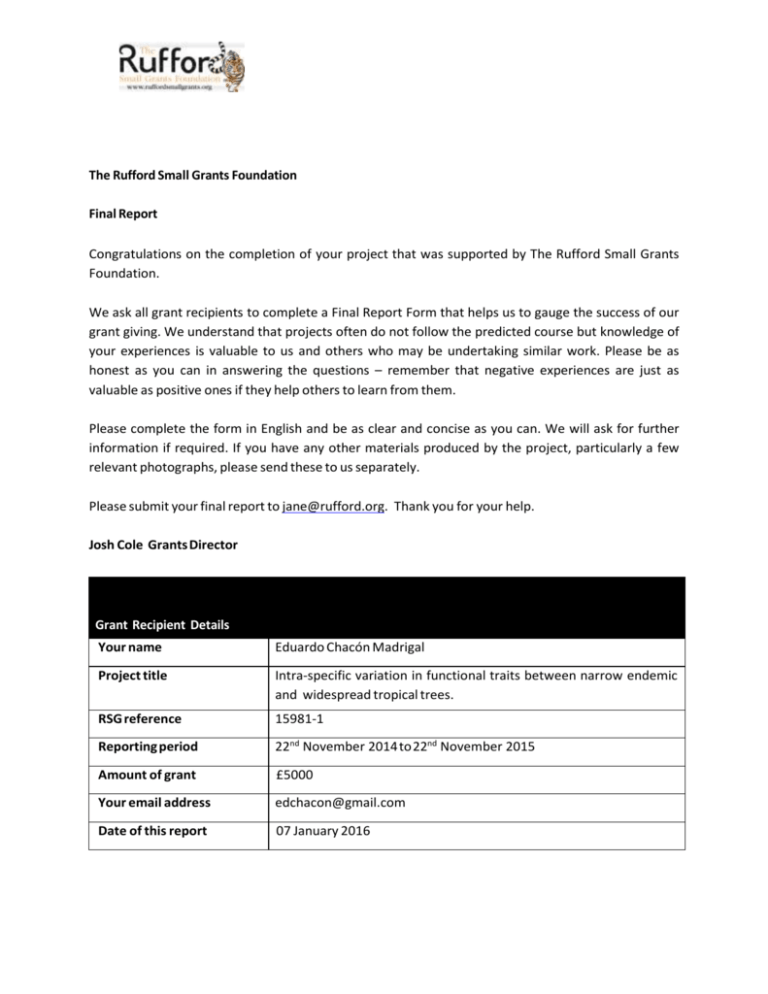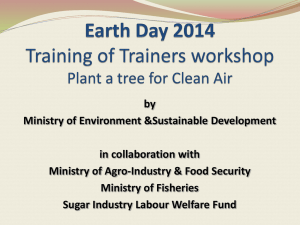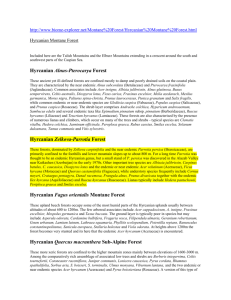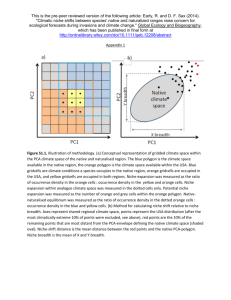Final Report - Rufford Foundation
advertisement

The Rufford Small Grants Foundation Final Report Congratulations on the completion of your project that was supported by The Rufford Small Grants Foundation. We ask all grant recipients to complete a Final Report Form that helps us to gauge the success of our grant giving. We understand that projects often do not follow the predicted course but knowledge of your experiences is valuable to us and others who may be undertaking similar work. Please be as honest as you can in answering the questions – remember that negative experiences are just as valuable as positive ones if they help others to learn from them. Please complete the form in English and be as clear and concise as you can. We will ask for further information if required. If you have any other materials produced by the project, particularly a few relevant photographs, please send these to us separately. Please submit your final report to jane@rufford.org. Thank you for your help. Josh Cole Grants Director Grant Recipient Details Your name Eduardo Chacón Madrigal Project title Intra-specific variation in functional traits between narrow endemic and widespread tropical trees. RSG reference 15981-1 Reporting period 22nd November 2014 to 22nd November 2015 Amount of grant £5000 Your email address edchacon@gmail.com Date of this report 07 January 2016 1. Please indicate the level of achievement of the project’s original objectives and include any relevant comments on factors affecting this. Objective Collect samples of 400 trees, 10 trees of 20 endemic species and 10 trees of 20 widespread species in the same genus. Not achieved Partially achieved x Fully achieved Measure functional traits for all the samples. x Quantify nutrients in the leaves (Nitrogen and Phosphorus content). x Collect localities of occurrences for all the species. x Comments I collected samples for 406 trees, but I have 17 species pairs (a pair is one endemic species and one widespread species in the same genus) almost complete and six pairs incomplete. The reason is because some endemic species were very rare to find. I have this variables complete for all the samples: specific leaf area, leaf dry-matter content, leaf area, leaf thickness, and wood specific gravity. I am still working with leaf shape and vain density. This work is more meticulous. Besides of nitrogen and phosphorus content, all macronutrients and micronutrients of leaves were quantified. 2. Please explain any unforeseen difficulties that arose during the project and how these were tackled (if relevant). The principal difficulty was to find individuals of endemic species. Endemic species are not only narrowed distributed, they also are very rare and sparse or very located in hard to reach places. In spite of having more than 12,000 identified trees in plots in the study site, for some species, we only found one or two individuals. We also walk in many places looking for trees, but they were very rare, even in previously reported localities of occurrences. For my research, I needed 10 individuals for 20 endemic species and 10 individuals of 20 widespread species. To tackle the rare species, I was looking for 30 endemic species because I knew some were rare. Now, I have all the samples for 17 pairs of species (endemic and widespread), which correspond to samples for 340 tree individuals. I have more than 400 tree individuals sampled, but more than 60 do not complete the samples for six species pairs. Other difficulties were in the field. First, some species are high trees, to sample this high trees, we had to be patient and slick, but sometimes we needed several hour to obtain one sample. In the meantime, we break one of the increment-borer when we were sampling one tree with very hard and fibrous wood. We had to stop the work in the field waiting for repair the increment-borer. 3. Briefly describe the three most important outcomes of your project. Now, I am analysing the data. I have valuable information about endemic trees. I do not have a paper ready because it is a slow process but I am working on it. I plan to have the first paper in the next four months. These are three important outcomes for the fieldwork. a) I have new information about the geographical distribution of endemic species. These could help to protected area managers and administrators to decide which areas are priorities to conservation, especially in a place under pressure by oil plant expansion. Some endemic species are very restricted and they are located in unprotected areas. I am working on maps for each species studied. These maps and the information related will be delivered to respective authorities and will be available for general public (Fig. 1). b) I have new information about functional traits of endemic and widespread tree species. These could help to understand the habitat requirements for each species and their ecological role in the ecosystem. This information is new for almost all the species studied and will be available for others researchers through databases (e.g. https://www.try-db.org/). c) I have new information about nutrients on trees. This could help to know the species nutritional requirements. For example, if we want to make conservation ex-situ and reproduce species in greenhouse or field conditions, we could supply seedlings with the nutrients in an adequate proportion. For example, there are some families in local communities in the study site growing endemic trees from seeds, but the knowledge for these species is null (Fig. 1). 4. Briefly describe the involvement of local communities and how they have benefitted from the project (if relevant). I had as field assistants, four people, who helped me to collect samples in the field. Three of these people are from local communities. I hired them to work for some time in a place with high unemployment. However, the relevant is that they were very interested in my project and they learned a lot about trees. One of them is a tourist guide and now, he is growing endemic trees for propagation in deforested areas. Furthermore, the maps and the information about Peninsula de Osa tree species (Fig.1) will be available for local students and tourist guides. 5. Are there any plans to continue this work? Definitely yes, I have found very interesting results in my data and tendencies, but in some cases, I need more data. I want to collect more data when I finish my doctoral studies. I have data about functional traits in vegetative parts of trees, but I would like to know more about functional traits in reproductive parts, as flowers and fruits. Also, I would like to know more about ecological relations with dispersers and pollinators. 6. How do you plan to share the results of your work with others? I am analysing my data to publish the results on papers. Also, I want to participate in scientific meetings to present my results. I have made my first presentation in "Workshop zur österreichischen Tropenforschung, Wien" (Workshop about Research on Austrian Tropics, Vienna, December 2015) at the University of Vienna. Scientists, students and the general public interested in supporting conservation projects in the tropical rainforest were participating at this meeting. Furthermore, I am working in produce detailed information about trees in Península de Osa (Fig.1) 7.Timescale: Over what period was the RSG used? How does this compare to the anticipated or actual length of the project? The RSG was used during field work phase of my research that is in the meantime of the project. Now I am analysing the data and working in the presentation of the results. I plan to finish all the project in 6-9 months, depending on revisions of my work. 8. Budget: Please provide a breakdown of budgeted versus actual expenditure and the reasons for any differences. All figures should be in £ sterling, indicating the local exchange rate used. Item Research Assistant Budgeted amount 1480 Actual amount 1480 Equipment Supplies Services 1400 304 1216 1400 304 2271 Difference Comments It is a partial cost of the item, the overall cost was complemented with CONICIT and UCR fellowships -1055 I pay for analysis of 354 samples, the price for each sample is CRC 5000, GBP 6,41 GBP = 779,25 CRC. Originally, I had planned to pay 200 samples with RSG. But finally I pay for 354 samples. The difference was covered by campaign in Instrumentl.com, and CONICIT fellowship. Fuel Total 600 5000 600 6055 -1055 9. Looking ahead, what do you feel are the important next steps? The next steps are: a) Publish the results of this research on scientific papers and present the results at meetings. b) Publish the information collected in an accessible manner to the general public, especially for young students and naturalists. b) Using the results in the planning of conservation strategies. The tropical forest in southern of Costa Rica is under pressure by palm oil expansion. It is very necessary to improve the conservation strategies to ensure the conservation of rare species. The knowledge about the geographical distribution and habitat requirements for rare, endemic and threatened species is fundamental in the planning of this strategies. The data about this research and the interpretation of the results will be delivered to authorities in Costa Rica, who are responsible for the administration of natural resources and conservation. 10. Did you use the RSGF logo in any materials produced in relation to this project? Did the RSGF receive any publicity during the course of your work? Yes, I have not been able to use it many times, but I do it when I could. I used it in the first presentation of my research and the RSGF logo will be in the acknowledgments section of all my future presentations. Also, I will reproduce the RSGF logo in all the material that I will made with this information (See. Fig. 1) 11. Any other comments? I thanks to Rufford Foundation because without the fellowship, It would not have been possible the ongoing research. You will be sure, I will to acknowledge to RFSG in the papers and material that I will produce in the future with these data. Fig. 1. Template for each species in the document about tree species studied. Fig. 2. Collecting samples in the field and measuring and drying leaves in the laboratory. Some images produced with analysis of data.










